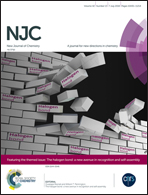2,3-Ethylene-bridged dihomooxacalix[4]arenes: synthesis, X-ray crystal structures and highly selective binding properties with anions†
Abstract
Three novel 2,3-ethylene-bridged p-tert-butyldihomooxacalix[4]arenes 3a–3c were selectively synthesized by direct O-alkylation of p-tert-butyldihomooxacalix[4]arene 1 with excess of 1,2-dibromoethane in controlled basic systems. Their corresponding conformational features were clearly elucidated by 1H NMR spectra and single crystal structures. Their binding abilities toward a variety of anions (SO42−, SO32−, CO32−, HSO3−, HCO3−, NO3−, CH3COO−, Br−, I− and Cl−) have been assessed (3a was taken for example) and compared to those afforded with the unconstrained p-tert-butyldihomooxacalix[4]arene 1 and the analogous 1,3-di-(2-bromoethyl) substituted calix[4]arene derivative 4 by determining the fluorescence titrations. The results showed that 2,3-ethylene-bridged dihomooxacalix[4]arene 3a has the most significant selectivity and high affinity for I−. In contrast, p-tert-butyldihomooxacalix[4]arene 1 can mainly bind most anions (SO32−, CO32−, HCO3−, NO3−, and I−), but has a poor selectivity preference. The analogous 4 exhibits only a weak binding ability for I−, which suggests that 2,3-ethylene-bridged p-tert-butyl-dihomooxacalix[4]arene 3a would be useful in the design of new selective supramolecular receptors for anions.
![Graphical abstract: 2,3-Ethylene-bridged dihomooxacalix[4]arenes: synthesis, X-ray crystal structures and highly selective binding properties with anions](/en/Image/Get?imageInfo.ImageType=GA&imageInfo.ImageIdentifier.ManuscriptID=C8NJ01284A&imageInfo.ImageIdentifier.Year=2018)


 Please wait while we load your content...
Please wait while we load your content...